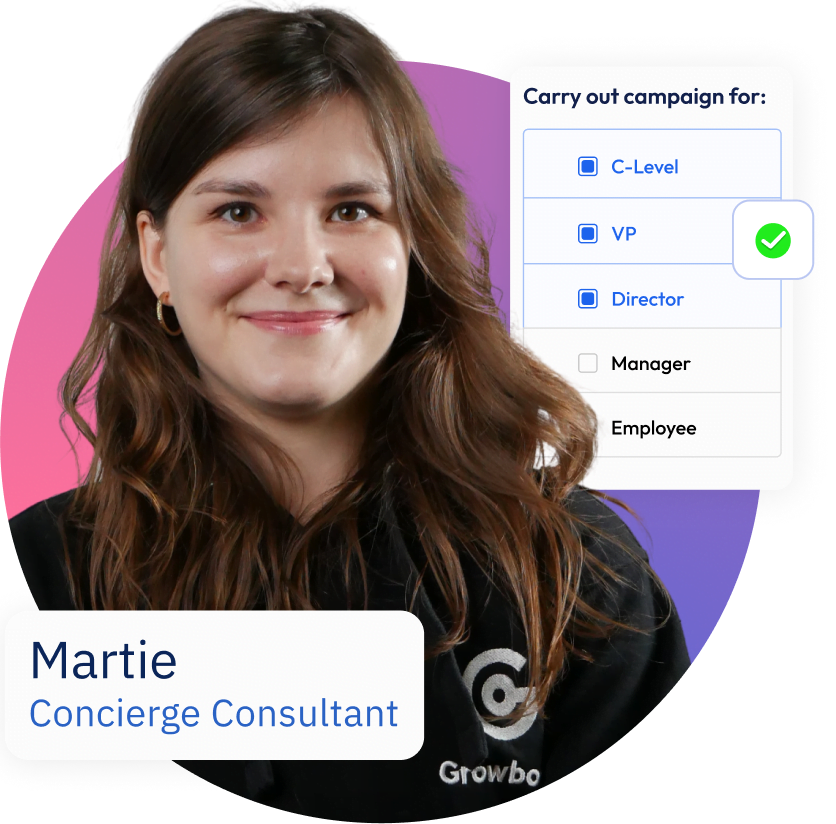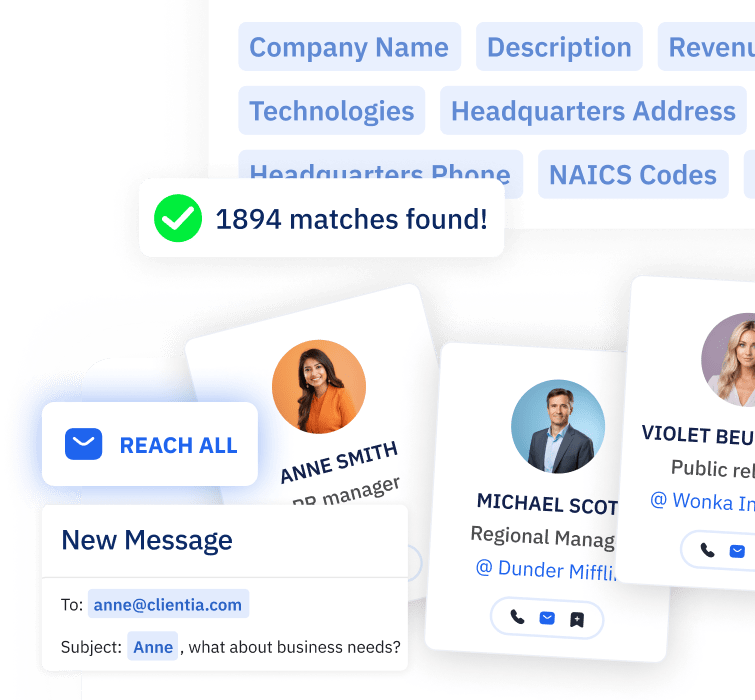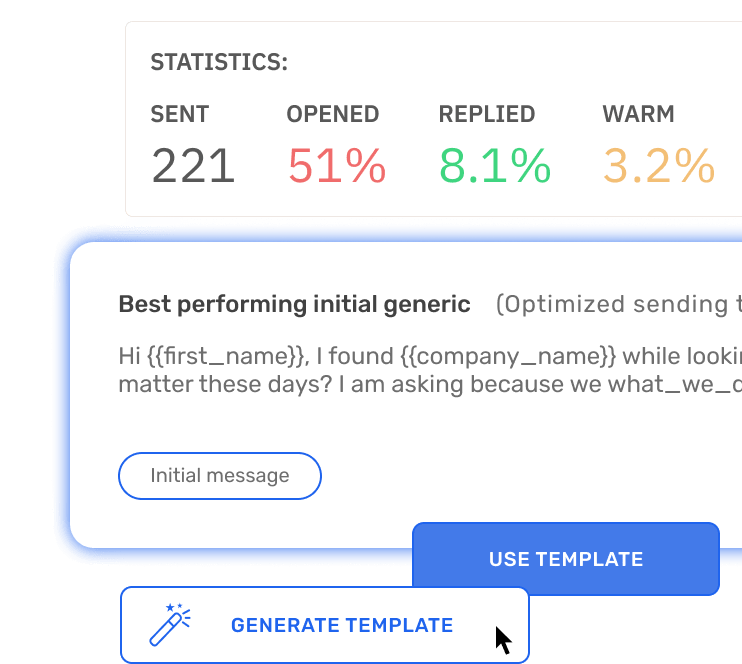In the fast-paced world of sales, prospecting stands as the bedrock upon which successful selling strategies are built. It is not just a foundational phase; it is indeed an ongoing process that fuels the sales pipeline and helps forge the paths to new business opportunities. Sales prospecting, or the act of identifying and reaching out to potential customers, is a critical task that demands both finesse and discipline.
By understanding the intricacies of this practice and executing it well, sales professionals can ensure a steady influx of high-quality leads that may eventually convert into valuable customers. In this guide, we’ll navigate through the essential facets of sales prospecting, offering actionable insights and leveraging the abundant knowledge resources available at Growbots.
leave no lead unexplored
Every potential client within reach
- 180m+ contacts
- CRM integrations
- 23 Prospect filters
- 15 Company filters
TL;DR
Sales prospecting is crucial as it fuels the sales pipeline, ensures business sustainability, provides a competitive advantage, enhances sales activities, and builds brand awareness.
Prospecting starts by understanding your Ideal Customer Profile (ICP) and using market research to build a list of potential prospects.
Key to effective sales prospecting is evaluating customer data, which involves the collection, analysis, and application of that data to enhance prospecting campaigns.
Choosing the right communication channel is vital for engaging potential customers, with options ranging from email, social media, phone calls, to in-person meetings.
Qualifying prospects is a fundamental process that involves understanding prospects’ needs, budget, decision-making process, and purchasing timeline.
Sales Cloud platforms can streamline sales prospecting by offering tools like centralized data management, automation, and analytics.
Lead scoring models prioritize prospects by assigning a value to specific attributes to focus effort on high-potential leads.
Personalizing messages is key for successful prospecting, as it shows an understanding of prospects’ unique challenges and solutions.
A variety of sales prospecting techniques should be employed, from cold calling to social selling, to generate quality leads.
Video has become a popular tool in prospecting due to its engagement, clarity in communication, and trust-building capacity.
Time management is critical in prospecting, with tips such as blocking time for prospecting, focusing on prime times, and tracking and refining strategies.
Social media prospecting is an integral part of sales strategy, using platforms like LinkedIn, Twitter, and Instagram to research, connect, and engage with potential customers.
Webinars are effective for lead generation as they educate, engage the audience, and offer a platform for follow-up.
The proposal stage is crucial as it overlaps with the sales cycle, and effective proposals are tailored with clear value propositions and strong calls to action.
Follow-up processes maintain momentum with potential customers, with methodologies involving timely correspondence, multiple touchpoints, and value reinforcement.
Prospects should be prioritized based on criteria such as need, budget, authority, and timing to focus on high-conversion potential leads.
Sales prospecting requires adaptation to different stages of the buyer’s journey: awareness, consideration, and decision.
Both inbound and outbound prospecting are essential, with inbound prospecting drawing customers in and outbound actively reaching out to them.
The guide concludes that successful sales prospecting is ongoing and requires a mix of strategic thinking, persistence, and a strong understanding of market and tools.
Introduction to Sales Prospecting
Sales prospecting signifies the proactive search for potential clients—known as prospects—with the aim to ignite the initial spark of interest and nurture them into your sales funnel. In this age of intense market competition, its importance can’t be overstated; prospecting can be the distinction between a thriving business and one that’s struggling to make ends meet.
More than 40% of salespeople say prospecting is the most challenging part of the sales process, emphasizing the need for effective prospecting strategies.
Source: spotio.com
Prospecting should be considered an investment in the future health of your sales pipeline, as it essentially seeds the ground for future revenue. Here’s a snapshot of why sales prospecting deserves your full attention:
Importance of Prospecting | Explanation |
Fuels the Sales Pipeline | It brings a constant stream of potential leads. |
Ensures Business Sustainability | Regular prospecting activities lead to stability and growth. |
Provides Competitive Advantage | Staying ahead by having a better grasp on potential market opportunities. |
Enhances Sales Activities | Nurtures leads that could turn into sales. |
Builds Brand Awareness | Your outreach introduces and reinforces your brand in the market. |
For a more in-depth understanding of crafting effective sales pitches, you might want to visit Create Better Sales Pitch Decks.
no prior experience & time required
Find your winning outbound formula with Concierge
- 95% activities on our behalf
- Avoid in-house SDR hire
- Learn & Take over anytime
- Numerous A/B tests
Understanding Lead vs. Prospect
Before diving headfirst into prospecting, it’s paramount to comprehend the difference between a lead and a prospect. A lead is someone who might become a customer, possibly because they’ve shown some interest in your product or because they fall into a category that matches your target market. On the other hand, a prospect is a qualified lead who has been determined to fit your target market, shows interest, and is deemed to have the potential to purchase.
The journey from lead to prospect involves identifying whether the lead qualifies as a potential customer, which requires understanding of MQLs (Marketing Qualified Leads) and SQLs (Sales Qualified Leads). MQLs are leads who have engaged with your marketing team’s efforts but aren’t ready to receive a sales call. SQLs, in contrast, have passed the tests of initial interest and fit and are ready to engage in the sales process.
Lead | Prospect |
Shows some interest or demographic fit | Has been qualified based on certain criteria |
Might not be aware of their need | Recognizes a potential need or pain point |
Is not yet ready to be approached by sales | Is ready to engage in the buying process |
For a concrete look at how Growbots approaches these challenges, explore Lead vs. Prospect vs. Opportunity.
Starting the Prospecting Process
Initiating the prospecting process requires a strategic approach. The first step involves delineating your target market and crafting an Ideal Customer Profile (ICP). With a clear understanding of who your ideal customers are, sales teams can tailor their prospecting activities to those most likely to convert.
By leveraging internal and external data sources, you can pinpoint the businesses and individuals who would benefit most from your offerings. Here’s a step-by-step approach to getting started:
- Identify Your ICP: Determine the attributes of the businesses or individuals who make the best customers for your product or service.
- Market Research: Gather information about the identified segments to better understand their needs and how your product addresses them.
- List Building: Create a list of potential prospects based on your research — a crucial step for which tools and platforms like Growbots can offer significant aid.
Intrigued by how Growbots can help you with list building? Check out How to Build a Sales Prospecting List for more insights.
Evaluating Customer Data
The role of customer data mining in sales prospecting is unmistakably vital. This involves the collection and analysis of data to understand customer behavior, preferences, and trends that can influence sales strategies. Effective data mining will unearth the golden nuggets — the prospects who are most likely to engage with your outreach and convert.
Customer Data Evaluation Steps | Purpose |
Data Collection | Gather information from various sources to build a robust prospect list. |
Data Analysis | Examine the data to discern patterns and actionable insights. |
Data Application | Implement the gleaned insights into your prospecting campaigns for enhanced relevance and personalization. |
Become an expert in managing customer data with our article on What Is Lead Qualification?
Finding the Right Communication Channel
Selecting the right communication channel is crucial as it forms the bridge between you and your potential customers. Whether it’s through email, social media, phone calls, or in-person meetings, understanding which channel resonates with your target audience can make a remarkable difference.
Seek, pick, and reach
Connect with your potential customers
- 180m+ contacts
- Advanced filtering
- Multichannel sequences
- CRM integrations
The following list highlights some widely-used communication channels suitable for various scenarios:
- Email: Great for personalized, scalable outreach;
- Social Media: Ideal for engaging contacts and building brand presence;
- Phone Calls: Foster a more personal connection and immediate feedback;
- In-Person Meetings: Create a deeper rapport and trust with prospects.
70% of salespeople find LinkedIn to be the most effective platform for connecting with customers, underscoring the importance of social selling in today’s digital age.
Source: leadsquared.com
To master the art of email outreach and avoid the spam folder, you should head over to 17 Reasons Your Outbound Emails Go to Spam and How to Fix It.
Qualifying Sales Prospects
Qualification is a linchpin of efficient sales prospecting. By scrutinizing potential prospects against predetermined criteria, sales teams can ensure they allocate their energy and resources to those most likely to become customers.
Prospect qualification involves asking the right questions, understanding the prospect’s needs, and gauging their level of interest and buying capacity. This process is pivotal in distinguishing between who is merely interested and who is ready — and able — to buy.
Prospect Qualification Steps | Objective |
Needs Assessment | Understand the prospect’s business needs. |
Budget Inquiry | Ascertain the prospect’s budget for your offering. |
Decision-Making Understanding | Identify who makes the purchasing decisions. |
Timeline Determination | Learn the prospect’s expected timeline for a purchase decision. |
Examine the nuances of How to Automate Your Outbound Sales to enhance your qualification process.
Using Sales Cloud for Prospecting
The integration of Sales Cloud platforms into the prospecting process epitomizes how technology can vastly improve sales activities. These platforms offer a suite of tools enabling sales teams to organize, track, and nurture leads through the sales funnel more efficiently.
The adoption of a Sales Cloud comes with numerous benefits:
- Centralized Data: Streamlines information access and updates across the team.
- Automation: Automates routine tasks, allowing reps to focus on high-impact activities.
- Analytics: Provides real-time insights that can inform strategy adjustments.
Sales Cloud tools are often equipped with prospecting modules designed to simplify lead management and give sales reps a competitive edge.
For a closer look at the functionalities of a Sales Cloud, explore Sales Prospecting with Growbots.
Lead Scoring Strategies
Lead scoring is the tactic used to rank prospects against a scale that represents the perceived value each lead represents to the organization. Effective lead scoring strategies can significantly enhance the efficiency of the prospecting phase by helping prioritize lead engagement activities.
By assessing various characteristics such as demographic information, engagement behavior, and more, sales teams can assign scores to leads and focus their attention where it’s most deserved.
Here are some steps to formulate a robust lead scoring model:
- Identify and organize lead qualities and behaviors.
- Assign numeric value to each of these attributes based on perceived importance.
- Administer the lead scoring model in your CRM or Sale Cloud platform for systematic segmentation and prioritization.
For a more thorough understanding and implementation of lead scoring models, access Lead Scoring Outbound Sales.
Outreach with Personalized Messages
In the realm of sales prospecting, personalized messages play an indispensable role. Personalization goes beyond mere cordiality; it demonstrates to potential customers that you truly understand their unique challenges and that your product or service provides the solution.
Personalized outreach can not only increase engagement rates but also helps in building meaningful relationships. It involves meticulously crafted messaging that resonates with the individual interests and needs of your prospects.
For tips on sending tailored messages that strike the right chord, visit Effective Cold Email Opening Lines.
Sales Prospecting Techniques
Employing a variety of sales prospecting techniques can be transformative. The modern sales landscape offers a wealth of methods, from classic cold calling to social selling, each with its own set of tactics and best practices.
Outbound prospecting techniques like cold emailing and networking events still hold a powerful sway, while inbound methods rely on creating compelling content that draws in prospects organically. Learning to blend these strategies effectively can help generate not only a higher quantity of leads but also better quality ones.
Discover 6 Secrets to Successful Sales Prospecting to amplify your technique repertoire.
Leveraging Video in Prospecting
With the advent of social media and the evolution of communication preferences, video outreach has become an increasingly popular prospecting tool. Videos can deliver a personalized experience in a scalable way, making complex products easier to understand and helping establish a brand identity.
Here’s why you should consider incorporating video into your prospecting efforts:
- Engagement: Creates more engaging and memorable outreach.
- Clarity: Helps explain products or services more clearly and effectively.
- Trust: Builds stronger rapport and trust with prospects.
Dedicating Time for Prospecting
Mastering prospecting time management is a crucial aspect of ensuring the success of your sales efforts. Given the range of tasks a sales representative must accomplish, it’s easy for prospecting to fall by the wayside. However, it is through dedicated and consistent prospecting that a healthy, robust sales pipeline is maintained.
Here are some tips on how sales reps can better manage their prospecting schedule:
- Block Time on Calendar: Reserve specific times in your calendar exclusively for prospecting.
- Focus on Prime Times: Identify periods when prospects are more likely to engage and plan your activities accordingly.
- Track and Refine: Monitor how you spend your prospecting time and continuously refine for better efficiency.
For additional insights on enhancing productivity, Tips for Sales Reps provides a wealth of knowledge.
Social Media in Sales Prospecting
In the current digital age, social media prospecting is an integral part of a comprehensive sales strategy. Platforms like LinkedIn, Twitter, and even Instagram offer unique opportunities to connect with prospects where they naturally congregate. Sales reps can leverage social networks to research, connect, and engage with potential customers through social selling strategies.
Elements to consider when using social media for prospecting:
- Profile Optimization: Ensure your social media profiles are professional and accurately reflect your brand.
- Valuable Content: Share content that positions you as a thought leader and adds value to your prospects.
- Genuine Engagement: Participate in discussions and engage genuinely with user content.
Hosting Webinars for Lead Generation
Webinars have become a powerful tool for sales prospecting, allowing businesses to demonstrate expertise and establish authority in their field. Hosting webinars can nurture leads and directly interact with a large audience simultaneously while providing informative and valuable content.
Successful webinars:
- Educate: Offer a compelling topic that teaches the audience something new.
- Engage: Encourage participation through Q&A sessions, polls, and interactive discussions.
- Follow-up: Use it as a stepping stone for further engagement with attendees.
The Role of Proposals in Prospecting
Creating and presenting proposals is often the point at which the sales prospecting process overlaps with the beginning of the sales cycle. A well-crafted proposal can be the deciding factor in whether a prospect takes the next step toward becoming a customer.
Key aspects of an effective proposal:
- Tailored Solutions: Highlight how your offering addresses the specific needs of the prospect.
- Clear Value Proposition: Communicate the benefits and results the prospect can expect.
- Compelling Call to Action: Lead the prospect towards the next phase in the sales journey.
Follow-Up Processes in Prospecting
The follow-up process is an indispensable stage in the prospecting journey. It helps maintain momentum with potential customers who have shown initial interest. Knowing when and how to follow up can mean the difference between a lost opportunity and a sale.
Reach More with Less Effort
Connect with Potential Clients at scale
- AI message generator
- E-mail verification
- Multichannel sequences
- A/B testing
Effective follow-up methodologies include:
- Timely Correspondence: Reach out within an appropriate time frame after the first contact.
- Multiple Touchpoints: Use a combination of email, phone calls, and social media for follow-ups.
- Value Reinforcement: Remind prospects of the benefits and solutions provided by your product or service.
A first follow-up email can significantly boost the reply rate by 49%, making it a crucial step in the sales prospecting process.
Source: hubspot.com
To master the follow-up process, explore insights from Follow-Up Process.
Prioritizing Your Prospects
Not all prospects are created equal. Therefore, prioritizing prospects becomes a strategic endeavor aimed at focusing efforts on those with the highest potential for conversion. Applying criteria such as need, budget, authority, and timing can help sales reps identify which leads to focus on.
Techniques to prioritize prospects:
- Segmentation: Divide your prospect list into categories based on their potential value.
- Scoring: Apply lead scoring to rank prospects according to specific criteria.
- Review and Adjust: Regularly review your list to reflect changes in prospect status.
For methods on effective prioritization, Prospect Qualification offers valuable strategies.
Sales Prospecting in Different Stages
The approach to sales prospecting may vary depending on where the prospect falls within the sales funnel. An understanding of the different stages of the buyer’s journey can guide you to customize your tactics and messaging for maximum impact.
Sales Funnel Stage | Adaptation Strategy |
Awareness | Educate on pain points and solutions. |
Consideration | Provide comparisons and case studies. |
Decision | Address objections and offer incentives. |
Inbound vs. Outbound Sales Prospecting
The duality of inbound and outbound sales prospecting signifies two fundamentally different, yet complementary approaches to acquiring new customers. Inbound prospecting is characterized by drawing potential customers in through content marketing, SEO, and social media engagement. Meanwhile, outbound prospecting involves actively reaching out to prospects through channels such as cold calling, emailing, or direct messaging.
Each method has its place within a balanced sales strategy. Inbound methods can be cost-effective and long-term oriented, while outbound techniques are direct and results-driven, often yielding quicker responses.
By understanding the strengths of each and crafting a strategy that incorporates both, businesses can enjoy a more robust and diversified approach to building their client base. Explore how to create a harmonious balance between the two through Inbound and Outbound Sales.
Conclusion
Sales prospecting is not merely a phase in the sales cycle; it’s an ongoing dedication to finding and nurturing potential customers. It is the pulse that keeps the sales heart beating, requiring innovation, persistence, and a deep understanding of both your market and the tools at your disposal. From leveraging cutting-edge Sales Cloud platforms to mastering the art of communication, each aspect of this guide is aimed at empowering sales professionals in the art of prospecting.
Whether you’re crafting personalized outreach or prioritizing your prospects, remember that at the heart of prospecting lies the perennial goal: to foster relationships that convert to sales and enhance business growth.
Armed with this sales prospecting guide and the plentiful resources available at Growbots, you’re well on your way to streamlining your prospecting process and achieving unparalleled sales success.
FAQ Section
What is the difference between a lead and a prospect?
Leads are individuals or organizations that have shown some interest in your products or services, typically as a result of marketing efforts. Prospects are leads that have been further qualified based on certain criteria such as need, budget, and decision-making authority, making them more likely to become customers.
How often should I follow up with a prospect?
Timing and frequency of follow-ups can greatly affect the success of prospecting. A good rule of thumb is to follow up within a few days of the initial contact, and then periodically after that. However, it’s important to tailor the follow-up schedule to the prospect’s responses and behaviors.
What are the best tools for sales prospecting?
There are numerous sales prospecting tools available that serve different purposes, from customer relationship management (CRM) systems to sales intelligence and lead generation software. Some of the top-rated tools include HubSpot, Salesforce, and LinkedIn Sales Navigator.
How can I use social media for sales prospecting?
Social media can be used for prospecting by engaging with potential customers, sharing relevant content, and building a brand presence that attracts leads. Platforms like LinkedIn are particularly valuable for B2B prospecting.
Is it better to prioritize inbound or outbound sales prospecting?
The choice between inbound and outbound prospecting depends on your business model, resources, and target market. Both strategies can be effective, and many successful sales teams use a combination of inbound and outbound methods.
How does lead scoring improve the prospecting process?
Lead scoring helps sales teams prioritize and focus their efforts on the leads that are most likely to result in a sale. This is usually done by assigning numerical values to various lead attributes and behaviors to indicate their sales-readiness.
Can video outreach be measured effectively in terms of ROI?
Video outreach can be measured in terms of engagement, response rates, and conversion rates, all of which can be tied back to ROI. Tools that track video views, watch time, and follow-up actions can provide valuable metrics.


































